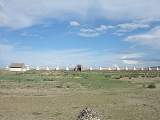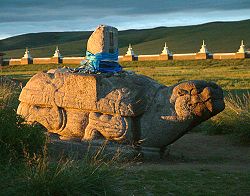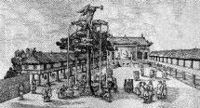
Karakorum
Encyclopedia




Capital City
Capital City was a television show produced by Euston Films which focused on the lives of investment bankers in London living and working on the corporate trading floor for the fictional international bank Shane-Longman....
of the Mongol Empire
Mongol Empire
The Mongol Empire , initially named as Greater Mongol State was a great empire during the 13th and 14th centuries...
in the 13th century, and of the Northern Yuan in the 14-15th century. Its ruins lie in the northwestern corner of the Övörkhangai Province of Mongolia
Mongolia
Mongolia is a landlocked country in East and Central Asia. It is bordered by Russia to the north and China to the south, east and west. Although Mongolia does not share a border with Kazakhstan, its western-most point is only from Kazakhstan's eastern tip. Ulan Bator, the capital and largest...
, near today's town of Kharkhorin
Kharkhorin
Kharkhorin is a city and sum center in the Övörkhangai Province in Mongolia. Sum population was 13,828 , 13,964 , 13,496. Kharkhorin city population is 8,977 , city area is 20.5 km2....
, and adjacent to the Erdene Zuu monastery
Erdene Zuu monastery
The Erdene Zuu Monastery is probably the most ancient surviving Buddhist monastery in Mongolia. It is in Övörkhangai Province, near the town of Kharkhorin and adjacent to the ancient city of Karakorum...
. They are part of the upper part of the World Heritage Site
World Heritage Site
A UNESCO World Heritage Site is a place that is listed by the UNESCO as of special cultural or physical significance...
Orkhon Valley Cultural Landscape.
Foundation
The Orkhon valley was a center of the XiongnuXiongnu
The Xiongnu were ancient nomadic-based people that formed a state or confederation north of the agriculture-based empire of the Han Dynasty. Most of the information on the Xiongnu comes from Chinese sources...
, Göktürk
Göktürks
The Göktürks or Kök Türks, were a nomadic confederation of peoples in medieval Inner Asia. Known in Chinese sources as 突厥 , the Göktürks under the leadership of Bumin Qaghan The Göktürks or Kök Türks, (Old Turkic: Türük or Kök Türük or Türük; Celestial Turks) were a nomadic confederation of...
and Uyghur
Uyghur Empire
The Uyghur Khaganate, or, Uyghur Empire or Uighur Khaganate or Toquz Oghuz Country was a Turkic empire that existed for about a century between the mid 8th and 9th centuries...
empires. To the Göktürks, the nearby Khangai Mountains had been the location of the Ötüken
Ötüken
Ötüken Old Turkic: , Ötüken yïš, , Mount Ötüken, 於都斤山, Linghu Defen, Book of Zhou, Vol. 50, Li Dashi, Li Yanshou, History of Northern Dynasties, Vol. 9, 都尉揵山, Liu Xu etc, Book of Tang, Vol. 199-II, 烏德鞬山/乌德鞬山, Ouyang Xiu etc, New Book of Tang, Vol. 93, 都斤山, Yan Shigu, Kong Yingda etc, Book of Sui,...
, and the Uighur capital Karabalgasun was located close to where later Karakorum would be erected. This area is probably also one of the oldest farming areas in Mongolia.
In 1218/19, Genghis Khan
Genghis Khan
Genghis Khan , born Temujin and occasionally known by his temple name Taizu , was the founder and Great Khan of the Mongol Empire, which became the largest contiguous empire in history after his death....
rallied his troops for the campaign against the Khwarezm Empire in a place called Karakorum, but the actual foundation of a city is usually said to have only occurred in 1220. Until 1235, Karakorum seems to have been little more than a yurt
Yurt
A yurt is a portable, bent wood-framed dwelling structure traditionally used by Turkic nomads in the steppes of Central Asia. The structure comprises a crown or compression wheel usually steam bent, supported by roof ribs which are bent down at the end where they meet the lattice wall...
town; only then, after the defeat of the Jin empire, did Genghis' successor Ögedei
Ögedei Khan
Ögedei Khan, born Ögedei was the third son of Genghis Khan and second Great Khan of the Mongol Empire by succeeding his father...
erect walls around the place and build a fixed palace.
Prosperity
Under Ögedei and his successors, Karakorum became a major site for world politics. Möngke KhanMöngke Khan
Möngke Khan , born Möngke, , was the fourth Great Khan of the Mongol Empire from July 1, 1251 – August 11, 1259. He was the first Great Khan from the Toluid line, and made significant reforms to improve the administration of the Empire during his reign...
had the palace enlarged, and the great stupa
Stupa
A stupa is a mound-like structure containing Buddhist relics, typically the remains of Buddha, used by Buddhists as a place of worship....
temple completed. They also adorned the famous Silver Tree of Karakorum at the city center.
William of Rubruck
William of RubruckWilliam of Rubruck
William of Rubruck was a Flemish Franciscan missionary and explorer. His account is one of the masterpieces of medieval geographical literature comparable to that of Marco Polo....
, a Flemish Franciscan
Franciscan
Most Franciscans are members of Roman Catholic religious orders founded by Saint Francis of Assisi. Besides Roman Catholic communities, there are also Old Catholic, Anglican, Lutheran, ecumenical and Non-denominational Franciscan communities....
missionary and papal
Pope
The Pope is the Bishop of Rome, a position that makes him the leader of the worldwide Catholic Church . In the Catholic Church, the Pope is regarded as the successor of Saint Peter, the Apostle...
envoy to the Mongols
Mongol Empire
The Mongol Empire , initially named as Greater Mongol State was a great empire during the 13th and 14th centuries...
reached Karakorum in 1254. He has left one of the most detailed, though not always flattering, accounts of the city. He compared it rather unfavourably to the village of Saint-Denis
Saint-Denis
Saint-Denis is a commune in the northern suburbs of Paris, France. It is located from the centre of Paris. Saint-Denis is a sous-préfecture of the Seine-Saint-Denis département, being the seat of the Arrondissement of Saint-Denis....
near Paris, and was of the opinion that the royal abbey there was ten times as important as the Khan's palace. On the other hand, he also described the town as a very cosmopolitan and religiously tolerant place, and the silver tree he described as part of Möngke Khan's palace has become the symbol of Karakorum. He described the walled city as having four gates facing the four directions, two quarters of fixed houses, one for the "Saracen
Saracen
Saracen was a term used by the ancient Romans to refer to a people who lived in desert areas in and around the Roman province of Arabia, and who were distinguished from Arabs. In Europe during the Middle Ages the term was expanded to include Arabs, and then all who professed the religion of Islam...
es" and one for the "Cathai
Cathay
Cathay is the Anglicized version of "Catai" and an alternative name for China in English. It originates from the word Khitan, the name of a nomadic people who founded the Liao Dynasty which ruled much of Northern China from 907 to 1125, and who had a state of their own centered around today's...
", twelve pagan temples, two mosques, as well as a Nestorian
Nestorianism
Nestorianism is a Christological doctrine advanced by Nestorius, Patriarch of Constantinople from 428–431. The doctrine, which was informed by Nestorius's studies under Theodore of Mopsuestia at the School of Antioch, emphasizes the disunion between the human and divine natures of Jesus...
church.
Later Times
When Kublai KhanKublai Khan
Kublai Khan , born Kublai and also known by the temple name Shizu , was the fifth Great Khan of the Mongol Empire from 1260 to 1294 and the founder of the Yuan Dynasty in China...
claimed the throne of the Mongol Empire in 1260—as did his younger brother, Ariq Boke
Ariq Boke
Ariq Böke , the components of his name also spelled Arigh, Arik, Bukha, Buka , was the youngest son of Tolui , a son of Genghis Khan. After the death of his brother the Great Khan Mongke, Ariq Boke briefly took power while his brothers Kublai and Hulagu were absent...
—, he relocated his capital to Shangdu
Xanadu
-Description of Xanadu by Toghon Temur :The lament of Toghon Temur Khan , concerning the loss of Daidu and Heibun Shanduu in 1368, is recorded in many Mongolian historical chronicles...
, and later to Dadu
Khanbaliq
Khanbaliq or Dadu refers to a city which is now Beijing, the current capital of the People's Republic of China...
(today's Beijing
Beijing
Beijing , also known as Peking , is the capital of the People's Republic of China and one of the most populous cities in the world, with a population of 19,612,368 as of 2010. The city is the country's political, cultural, and educational center, and home to the headquarters for most of China's...
). Karakorum was reduced to the administrative center of a provincial backwater of the Yuan Dynasty
Yuan Dynasty
The Yuan Dynasty , or Great Yuan Empire was a ruling dynasty founded by the Mongol leader Kublai Khan, who ruled most of present-day China, all of modern Mongolia and its surrounding areas, lasting officially from 1271 to 1368. It is considered both as a division of the Mongol Empire and as an...
founded in China
China
Chinese civilization may refer to:* China for more general discussion of the country.* Chinese culture* Greater China, the transnational community of ethnic Chinese.* History of China* Sinosphere, the area historically affected by Chinese culture...
in 1271. Even worse, the ensuing wars with Ariq Boke and later Kaidu
Kaidu
Kaidu was the leader of the House of Ogedei and the de facto khan of the Chagatai Khanate. He ruled part of modern-day Xinjiang and Central Asia during the 13th century, and actively opposed his uncle, Kublai Khan, who established the Yuan Dynasty in China until his death in 1301...
hit the town hard. In 1260, Kublai disrupted the town's grain supply, in 1277 Kaidu took Karakorum, only to be ousted by Yuan
Yuan Dynasty
The Yuan Dynasty , or Great Yuan Empire was a ruling dynasty founded by the Mongol leader Kublai Khan, who ruled most of present-day China, all of modern Mongolia and its surrounding areas, lasting officially from 1271 to 1368. It is considered both as a division of the Mongol Empire and as an...
troops and Bayan of the Baarin
Bayan of the Baarin
Bayan of the Baarin , also known as "Bayan chingsang" or, to Marco Polo, as "Bayan Hundred Eyes" , was a Mongol general...
in the following year. In 1298/99 prince Ulus Buqa looted the markets and the grain storehouses. However, the first half of the 14th century proved to be a second time of prosperity: in 1299, the town was expanded eastwards, in 1311 and again from 1342 to 1346 the stupa temple were renewed.
Decline
After the collapse of the Yuan dynasty in 1368 Karakorum became the residence of Biligtü KhanBiligtü Khan
Biligtü Khan, born Ayushiridara , was a ruler of the Northern Yuan Dynasty in Mongolia...
in 1370. In 1388, Ming
Ming Dynasty
The Ming Dynasty, also Empire of the Great Ming, was the ruling dynasty of China from 1368 to 1644, following the collapse of the Mongol-led Yuan Dynasty. The Ming, "one of the greatest eras of orderly government and social stability in human history", was the last dynasty in China ruled by ethnic...
troops took and destroyed the town. Saghang Sechen's Erdeni-yin Tobči claims that a khuriltai in 1415 decided to rebuild it, but no archeological evidence for such a venture has been found yet. However, Karakorum was inhabited at the beginning of the 16th century, when Batu-Möngke Dayan Khan made it a capital once again. In the following years, the town changed hands between Oirads and Chinggisids several times, and was consequently given up permanently.
Excavations
Erdene Zuu monasteryErdene Zuu monastery
The Erdene Zuu Monastery is probably the most ancient surviving Buddhist monastery in Mongolia. It is in Övörkhangai Province, near the town of Kharkhorin and adjacent to the ancient city of Karakorum...
stands near the site. Various construction materials were taken from the ruin to build this monastery.
The actual location of Karakorum was long unclear. First hints that Karakorum was located at Erdene Zuu were already known in the 18th century, but until the 20th century there was a dispute whether or not the ruins of Karabalgasun, or Ordu-Baliq, were in fact those of Karakorum. In 1889, the site was conclusively identified as the former Mongol capital by Nikolai Yadrintsev
Nikolai Yadrintsev
Nikolai Mikhailovich Yadrintsev was a Russian public figure, explorer, archaeologist, and turkologist. His discoveries include the Orkhon script, Genghis Khan's capital Karakorum and Ordu-Baliq, the capital of the Uyghur Khaganate. He was also one of the founding fathers of Siberian separatism.-...
, who discovered examples of the Orkhon script
Orkhon script
The Old Turkic script is the alphabet used by the Göktürk and other early Turkic Khanates from at least the 7th century to record the Old Turkic language. It was later used by the Uyghur Empire...
during the same expedition. Yadrintsev's conclusions were confirmed by Wilhelm Radloff.
The first excavations were done in 1933/34 under D. Bukinich. After his Soviet-Mongolian excavations in 1948/49, Sergei Kiselyov concluded that he had found the remains of Ögödei's palace. However, this conclusion has been put into doubt by the findings of the 2000-2004 German-Mongolian excavations, which seem to identify them as belonging to the great stupa temple rather than to Ögödei's palace.
Findings of the excavations include paved roads, some brick
Brick
A brick is a block of ceramic material used in masonry construction, usually laid using various kinds of mortar. It has been regarded as one of the longest lasting and strongest building materials used throughout history.-History:...
and many adobe
Adobe
Adobe is a natural building material made from sand, clay, water, and some kind of fibrous or organic material , which the builders shape into bricks using frames and dry in the sun. Adobe buildings are similar to cob and mudbrick buildings. Adobe structures are extremely durable, and account for...
buildings, floor heating systems, bed-stoves
Kang bed-stove
The Kang is a traditional long sleeping platform made of bricks or other forms of fired clay and more recently of concrete in some locations. Its interior cavity, leading to a flue, channels the exhaust from a wood or coal stove...
, evidence for processing of copper, gold, silver, iron (including iron wheel nave
Nave
In Romanesque and Gothic Christian abbey, cathedral basilica and church architecture, the nave is the central approach to the high altar, the main body of the church. "Nave" was probably suggested by the keel shape of its vaulting...
s), glass, jewels, bones, and birch bark
Birch bark
Birch bark or birchbark is the bark of several Eurasian and North American birch trees of the genus Betula.The strong and water-resistant cardboard-like bark can be easily cut, bent, and sewn, which made it a valuable building, crafting, and writing material, since pre-historic times...
, as well as ceramics and coins from China and Central Asia. Four kiln
Kiln
A kiln is a thermally insulated chamber, or oven, in which a controlled temperature regime is produced. Uses include the hardening, burning or drying of materials...
s have also been unearthed.
Modern days

See also
- Architecture of MongoliaArchitecture of MongoliaThe traditional Mongolian dwelling is known as yurt . According to Mongolian artist and art critic N. Chultem, yurts and tents were the basis for the development of traditional Mongolian architecture. In the 16th and 17th centuries, lamaseries were built throughout the country. Many of them started...
- Ordu-BaliqOrdu-BaliqOrdu-Baliqalso spelled Ordu Balykh, Ordu Balik, Ordu-Baliq, Ordu Balig, Ordu Baligh , also known as Mubalik, was the capital of the first Uyghur Empire, built on the site of the former Göktürk imperial capital, 17 km north-to-northeast of the later Mongol capital, Karakorum...
- The Black City of Khara-KhotoKhara-KhotoKhara-Khoto was a Tangut city in the Ejin khoshuu of Alxa League, in western Inner Mongolia, near the former Gashun Lake. It has been identified as the city of Etzina, which appears in The Travels of Marco Polo.-History:...
- XanaduXanadu-Description of Xanadu by Toghon Temur :The lament of Toghon Temur Khan , concerning the loss of Daidu and Heibun Shanduu in 1368, is recorded in many Mongolian historical chronicles...
Literature
- Dschingis Khan und seine Erben (exhibition catalogue), München 2005
- Qara Qorum-City (Mongolia). 1: Preliminary Report of the Excavations, Bonn 2002
External links
- This article incorporates public domain text posted on-line by The United States Library of Congress: A Country Study: Mongolia.
- Silk Road Seattle - Karakorum and Cities along the Silk Road, posted at the web site of the University of Washington, 2004.
- Treasures of Mongolia - Karakorum, Mongolia, UNESCO Courier, by Namsrain Ser-Odjav, March 1986.
- William of Rubruck's Account of the Mongols
- Mongolian-German excavations (in German)

